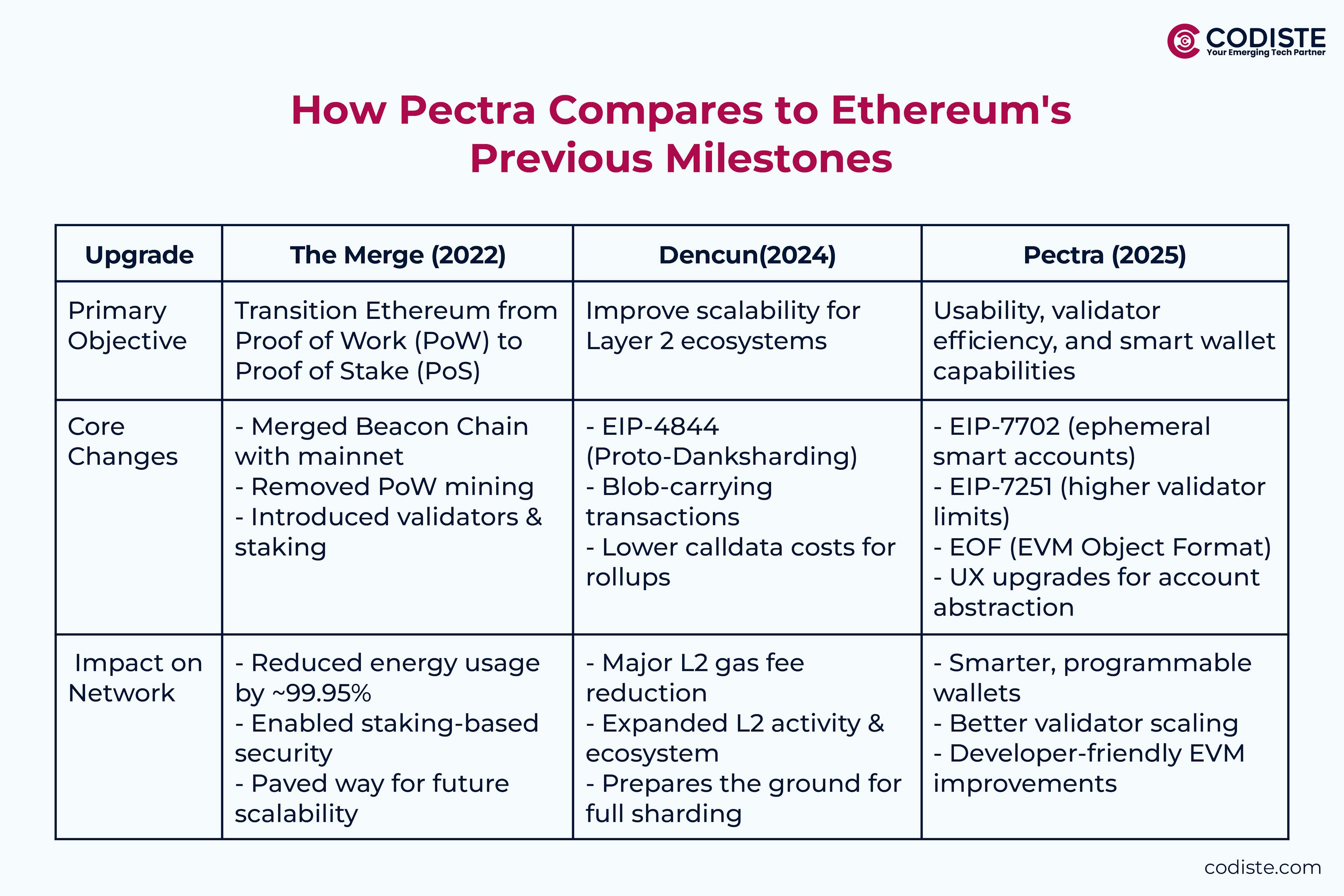
,
Ethereum reached a significant milestone on May 7, 2025, which blockchain developers and cryptocurrency fans have been looking forward to for years. The most extensive and revolutionary update to the Ethereum evolution network since The Merge radically changed its consensus mechanism in 2022, was the Pectra upgrade, which is a combination of Prague and Electra.
However, how does Pectra position Ethereum for the upcoming stage of blockchain development, and why is it so important? Its unparalleled reach, user-centred innovations, and calculated reaction to the growing competition in the smart contract platform market hold the key to the solution.
What is Pectra Ethereum
By integrating the Electra consensus layer and the Ethereum Prague upgrade execution layer hard fork, which were initially intended to be two distinct major updates, into a single, well coordinated event, Pectra marks a new strategy for Ethereum upgrades. Because of this deliberate consolidation, the Ethereum development group was able to simultaneously deploy significant modifications to several different areas of the network.
The data by itself paints a powerful picture: Pectra is Ethereum's most feature rich upgrade yet, implementing 11 EIP (Ethereum Improvement Proposals). This upgrade is more ambitious and comprehensive than any other, demonstrating Ethereum's resolve to stay the industry leader in smart contract technology.
Revolutionary Features That Redefine User Experience
Account Abstraction: Making Wallets Intelligent
The introduction of account abstraction capabilities in EIP-7702, which revolutionises user interaction with the Ethereum network, is arguably Pectra's most user facing innovation. With this update, standard wallets can now function as smart contracts, opening up functionalities that were previously unfeasible or very difficult.
Now that users can group several transactions, multi-step operations become simpler and use less gas. Most importantly, the update makes it possible for customers to pay for petrol in a variety of ways, including with tokens like USDC, rather than only ETH. A significant obstacle to widespread adoption is eliminated by this seemingly straightforward modification, since users no longer need to keep ETH on hand for transaction fees.
The advent of session keys and programmable wallets improves security and usability even more by enabling automated transaction approval for reliable applications and more complex authentication techniques.
Staking Revolution: From 32 ETH to 2,048 ETH
With EIP-7251, the maximum validator stake is increased from 32 ETH to 2,048 ETH, marking a significant change in Ethereum's staking economics. In addition to providing new options for institutional and individual stakeholders, this modification fixes some significant shortcomings in the current staking system.
With this adjustment, operational complexity is significantly reduced for major stakeholders. The consolidation of holdings into fewer, larger 32 ETH validators is an option for major staking operations, as opposed to managing dozens or hundreds of independent validators. In addition to simplifying key management and lowering hardware requirements, this consolidation increases overall staking efficiency.
Because solo staking has less technical overhead to participate in network validation, the improvement also increases the appeal of solo staking, which could eventually improve Ethereum's decentralisation profile.
Layer-2 Scaling: Building on Dencun's Foundation
With Pectra, blob throughput for rollups is significantly increased, building on the proto danksharding that was introduced in the Ethereum Dencun upgrade. The rollup centric scaling method, in which the main chain acts as a secure settlement layer and Layer-2 solutions manage the bulk of transaction volume, is what Ethereum evolution is moving towards with this improvement.
Popular Layer-2 networks like Arbitrum, Optimism, and Polygon provide reduced prices to customers as a direct result of the higher throughput, making decentralised apps more affordable and accessible for common use cases.
How Pectra Compares to Ethereum's Previous Milestones

The Merge (2022): Foundational Transformation
The most significant shift in Ethereum evolution was the Merge, which switched from the energy intensive Proof-of-Work consensus method to the more environmentally friendly Proof-of-Stake one. This update laid the groundwork for upcoming scalability enhancements while cutting Ethereum's energy usage by more than 99%.
However, the Merge ignored staking restrictions and user experience issues that have limited network involvement in favour of concentrating mostly on enhancements to the consensus mechanism.
Dencun (2024): Scaling Infrastructure
Through EIP-4844, the Ethereum Dencun upgrade included proto danksharding, which greatly increased the amount of block space available for rollup data and decreased the fees associated with Layer-2 transactions. The foundation for Ethereum's rollup-centric scaling strategy was established by this update.
Dencun achieved significant scaling advancements, but it ignored staking inefficiencies and wallet usability problems that kept widespread adoption from progressing.
Pectra (2025): Holistic Evolution
Pectra sets itself apart by adopting an all encompassing strategy that tackles several facets of the Ethereum evolution ecosystem at once. Pectra integrates substantial user experience improvements with profound technical advancements, in contrast to earlier upgrades that mostly concentrated on either consensus modifications or infrastructure scaling.
The 11 EIP (Ethereum Improvement Proposals) in the upgrade include staking system improvements, consensus layer optimisations, execution layer changes, and user experience improvements. This all-encompassing strategy shows how Ethereum's development philosophy has matured, progressing from fundamental adjustments to widespread enhancements intended for widespread use.
The Smart Contract Platform is the Foundation for DeFi apps, why wait now.
Hop in to get yours made right now.
Strategic Implications: Ethereum's Competitive Response
Pectra enters the market at a pivotal point in the race for blockchain platforms. Rivals such as Solana have increased their user adoption and developer mindshare by focusing on speed, affordability, and user-friendliness. Ethereum has to move past its reputation for expensive fees and complicated user interfaces, according to recent research that shows an increase in developer engagement on other platforms.
The update specifically fixes several Ethereum's competitive issues:
- User Experience Parity: By lowering the technical knowledge barrier that has prevented widespread adoption, account abstraction features help Ethereum's user experience become more in line with what users anticipate from contemporary financial applications.
- Economic Efficiency: Cost issues that have pushed users to other platforms are addressed by enhanced Layer-2 scaling and more effective staking processes.
- Developer Appeal: Improved wallet programmability and more adaptable gas payment choices give programmers the means to create increasingly complex and intuitive applications.
Validator Operations and Network Security
Pectra has a number of EIPs that streamline validator operations and increase network security in addition to user-facing enhancements. These modifications increase the effectiveness of staking withdrawals, strengthen validator management, and provide network users more choices.
Additionally, the upgrade offers more efficient call data charges and enhancements to the storage of historical block hashes, which lowers the processing overhead needed to maintain network consensus and makes it more cost-effective to retain and retrieve historical blockchain data.
Pectra’s Mass Adoption and Ecosystem Growth
Ethereum's evolution changed with Pectra. Scalable infrastructure, network security, and sustainable consensus methods were the main topics of previous updates. Pectra addresses competitive positioning, economic efficiency, and user uptake using these pillars.
The update's focus on user experience illustrates that Ethereum's development team knows market leadership requires more than technical skill. Accessibility and user experience become increasingly important as blockchain technology advances.
Improved staking economics, Layer-2 scaling, and account abstraction enable Ethereum ecosystem expansion. These changes help developers create user-friendly apps, make decentralized protocol interaction cheaper for users, and make staking more appealing to institutions for network security.
Conclusion
This Pectra upgrade success will depend on Ethereum adoption and ecosystem growth as well as its technological achievements, providing more powerful applications, simpler user interfaces, and better network operations.
Developers have greater user interface and program design choices with Pectra. It offers better payment options, better experiences, and lower rates. The stakeholders' economic and operational efficiency improves.
The months and years after Pectra starts, when competitors react to its enlarged feature set and the Ethereum Pectra upgrade adjusts to its additional capabilities, will determine its importance. However, the upgrade's breadth and user-centered approach suggest that Ethereum is positioning itself to target new user segments and use cases while maintaining its market position.
Codiste is already building for what Pectra unlocks. From modular dApps to smart wallet integration, we help businesses launch fast and scale confidently on Ethereum’s evolving infrastructure. Ready to lead the next wave? Let’s build.




